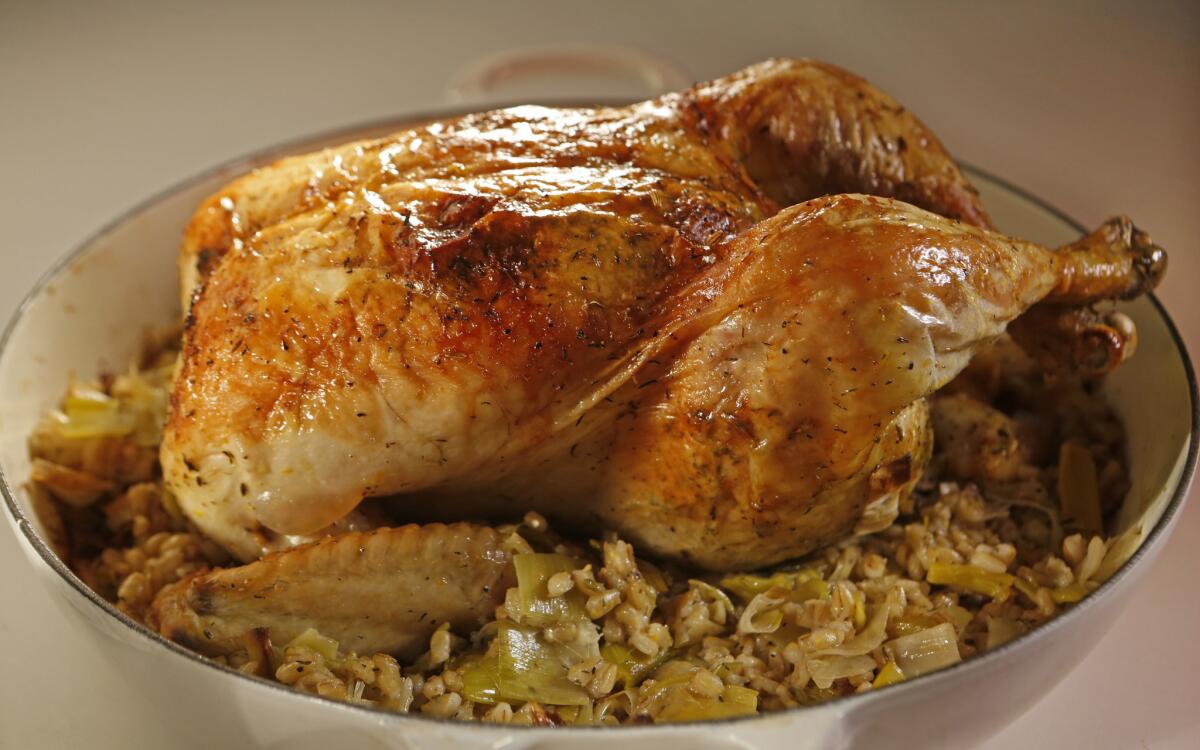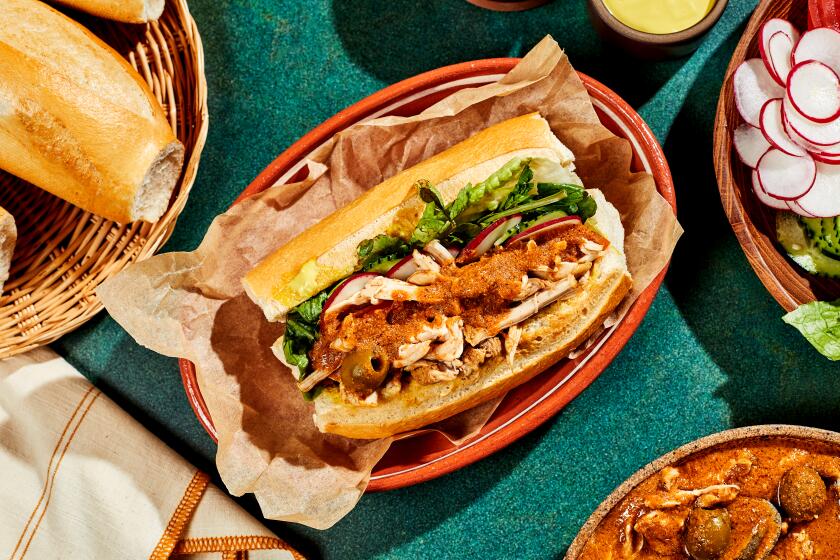Roasted one-pan chicken with leeks and barley

We all want to eat better, and most of us would love to have more meals with healthful and flavorful whole grains on our table. Yet, as a cookbook author specializing in them, whenever I ask during talks, “Did you cook some whole grains this week?” few hands go up in the room. And, as further prodding reveals, time or the lack of it seems to be the biggest hurdle.
It takes little to speed up your grain game. I spent the first part of my career working long and late hours as a news agency journalist. Still, whole grains were always on my table, for breakfast, lunch, dinner — and even for dessert. Here are five easy tricks:
1. Always have a few quick-cooking whole grains on hand. Today you can find many varieties, often gluten-free, on store shelves that can cook in 10 to 20 minutes, perfect for busy weeknights. This includes quinoa and also amaranth, buckwheat, millet and polenta or cornmeal. Not to forget farro (emmer wheat), trendy freekeh (toasted green wheat) and bulgur — which is called ancient fast-food for a reason. Last but not least, there’s also whole-wheat couscous, which needs nothing but a brief steaming to become a nourishing player on your mealtime table.
2. Store grains in individual Mason jars. This allows you to see at a glance what’s on hand and quickly choose a grain for dinner. For added ease, keep your favorite quick-cooking grains on an open kitchen shelf.
3. Prepare a large pot of slower-cooking whole grains on the weekend for later use. These include whole-wheat berries, spelt, rye and whole-grain barley. Cooking these hearty grains ahead enables you to work them into meals easily on busy nights. You can keep cooked grains at the ready in the fridge for up to seven days, or freeze them in portion sizes to always have on hand. (Two cups of raw grains will typically yield about six cups of cooked grains.)
4. Cooked grains keep in the freezer for months. You can defrost them overnight in the fridge, then briefly reheat them for dinner with 1/4 inch of water. Or cook them, straight from the freezer, in the microwave. (One cup of frozen grains needs only 1 to 2 minutes on high to be ready to eat.)
5. Be sure to soak slow-cooking grains overnight and cook them well, until some of them split and their starchy centers show. Don’t undercook these chewy whole grains. Why? Because when nicely plumped and supple, the kernels are much more appealing to eat — unless you love a mighty good chew.
Suggestions? Toss a cup of cooked grains into any soup or use them as a base for a more nourishing salad. Warm grains with milk for a quick breakfast that you can top with fresh fruit. Make grain burgers by adding grated vegetables, cheese, herbs and spices. Or add some cooked grains to pancake batter for brunch. You’ll be surprised how creative you can become once you have cooked grains at the ready.
Prepare the citrus rub: Finely grate the zest of the lemon and set aside. Halve the lemon crosswise, and cut one half into 2 pieces (save the other half for another use). In a small bowl, combine the lemon and orange zest, along with 1 teaspoon fennel seeds, 1 teaspoon dried thyme, 1/4 teaspoon black pepper and 2 teaspoons sea salt, and mix well with a fork. Set aside.
To prepare the chicken, pat it dry and trim any excess fat. Spread some citrus rub all over the skin and sprinkle inside the cavity. Using your fingers, gently loosen the skin from the breast meat and both thighs to create pockets so you can spread some of the citrus rub there as well. Place the 2 lemon pieces and the garlic inside the cavity and tie the legs with kitchen twine. Place the chicken on a plate and refrigerate, uncovered, for at least 4 hours and up to 24 hours.
About 21/2 hours before roasting, remove the chicken from the fridge and allow it to come to room temperature. Heat the oven to 475 degrees and oil a 12-inch cast-iron skillet or similar-sized roasting pan.
In a large bowl, combine the leeks with the remaining 11/2 teaspoons fennel seeds, 1/4 teaspoon salt and 1/4 teaspoon pepper. Drizzle with 2 tablespoons of the olive oil and toss to coat the vegetables. Spread the leeks across the bottom of the skillet. Rub the remaining 1 to 2 tablespoons olive oil across the skin of the chicken and sprinkle with the remaining 1/4 teaspoon salt. Place the chicken, breast-side up, on top of the leeks in the center of the skillet, and tuck the wing tips under the body.
Roast the chicken for 25 minutes. Reduce the oven temperature to 400 degrees and continue roasting until a thermometer inserted into the thickest part of the thigh reads 165 degrees, 25 to 40 minutes, depending on the size of the bird.
While the chicken is roasting, cook the barley: In a heavy 2-quart saucepan, combine the water, barley, zest and bay leaf, and bring to a boil. Reduce the heat to maintain a simmer, cover and cook until the grains are tender with a bit of a chew, 30 to 40 minutes. Remove the zest and the bay leaf. Drain and set aside.
When the chicken is done, remove the skillet from the oven and transfer the chicken to a large cutting board, loosely cover with aluminum foil and set aside to rest for at least 15 minutes.
Meanwhile, add the cooked grains to the leeks in the skillet and sprinkle with the remaining 1 teaspoon thyme. Pour over the wine — just enough to nicely moisten the grains and vegetables — and stir well to combine. Return the pan to the oven for about 10 minutes, until the grains are heated through, then turn off the oven and keep the door ajar until ready to serve.
Carve the chicken: Remove the leek and barley mixture from the oven, stir through once, and season to taste with salt and pepper. Serve each portion of leeks and barley with a piece of the chicken.
Get our Cooking newsletter.
Your roundup of inspiring recipes and kitchen tricks.
You may occasionally receive promotional content from the Los Angeles Times.















